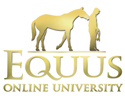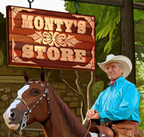Life with Woody has always been full of challenges which we have overcome and now I think I'm facing a biggy. Woods is about 24 now and old age seems to be showing it's face, bit of arthritis and mild asthma, but now the vet thinks he about 85% blind. Apparently once you notice behavioral issues, they reckon thats when they have lost about 85% of their vision. About 3 months ago we hacked out alone and he was so spooky, took my knee out going through a gateway, then turned and bolted when he heard pheasants stuck in a hedge. Which, don't get me wrong, would spook a few, but he has NEVER done that out on a hack even when he was a lot more spooky when i first got him. At first i thought it was because I was a bit nervous and we vibe off each other a lot, and maybe it was a bad day. But i didn't think i was that bad that day! I also started noticing that he turned his head to the outside of the school and put that down to being unbalanced so started addressing that.
So I did get the vet out to check his eyes and that when he said he has degenerative retinas. Had them checked again 3 months later and its a slight change so at least the change is slow (touch wood!) He can see better in daylight and really struggles in dim light. He still wants to do stuff and loves going for runs with me. WE also had started to do pole bending-in trot-which he absolutely loves! He knows his way around the yard and knows the steps into and out of the barn. And i think he knows roughly how big the school is in walk and trot, canter is a bit more difficult. We are trying to find hacking buddies that are friendly and safe so we can go out-not proving that easy but l'll keep trying!! I guide him as much as I can and he follows my lead most of the time and stops when i say to stand.
But what i want is just a few more ideas on how to help him and also advice on how to ride him. With it being winter and working full time, it's usually in the school with dim lights on. I used to ride with a contact but not too strong. The recently i started having lessons and my instructor said to ride with a lot stronger contact and he did seem to go well and helps to steer him. However, i did want to teach him to neck rein as i prefer the more western style and he did respond to that. But as he also has mild asthma and needs to do a few clearing coughs as he goes round, i have to give him his head. And this i think he prefers as he can sense where he is treading more. BUT then he does trip so i need a shorter rein! I am so confused as to how to handle this and don't want to give him mixed signals! I need to find one way and stick to it, especially now, so he has consistency so he has the confidence in me leading him on the right path.
Any and all help is much appreciated
Jess




Welcome back!
You seem to be doing quite well with Woody, his handicaps are not uncommon for this age.
Since he needs the excercise and the contact, I would suggest taking an old stirrup leather and put that around his neck. Get him used to being directed by your hands on the leather, without putting more pressure on the reins. Work incrementally, let him get used to the directing in a slow manner. It might give him a sense of security, something he can depend upon. It's your hands that provide it! Use voice cues, like you describe...
Using another horse as a guide when hacking is a great idea.
Choosing the right moment when to decide not to ride him anymore is a sensitive item.
It'll come your way sooner or later. Playing around and doing only groundwork might help you in the decision. What goes for any moment in a horse's life, is even more valid at old age: relationship first!
Please keep us posted,
Miriam
Jess, I wrote something to you yesterday, but when I hit the send key the mother ship intercepted the message and flew off somewhere else in our galaxy. Oh well!!.
What I wrote in my first effort regarding if Woods might have some saddle or other soreness brought on by riding. From you description of him acting out after your ride, my first thought was to check him out physically for pain.. That includes his mouth area also, especially if you ride with a bit.
The other thing that I wanted to mention was about him turning his head more than normal when ask to go in a certain direction. I had a young mare many years ago that had her eye put out in a pasture accident as a four yr. old. She was under saddle at the time. After the injury healed itself, I found that I had to retrain her so that she had confidence in me as a rider to keep her safe. I found that if I rode her down the fence line with the blind side next to the fence and the ask her for a turn into the fence to go in a different direction. She would hesitate at first, but in time, she started to trust my request with a quicker response. We built on that trust and eventually rode into the woods with a relaxed, confident go-ahead. She was an extremely hot mare, but with a fine mind to figure things out. My point here is that she would always turn her head so that the good eye could check out as to where to place her feet. Before long, NO BIG DEAL. She is 25 yrs old now and still going strong.
I hope that these suggestions gives a place to start from.
Bud
However, with that said, I can offer some advice as to HOW to incorporate neck reining into your riding with Woods. Neck reining was originally brought into focus by the Mexican vacaroes as they rode in a bosal with horsehair reins. As soon as the reins would touch the neck of the horse that they were riding the horse would turn away from the action of being tickled from the horse hairs.. This is the manner that they were taught. They brought this type of riding to an art form with their reinsmanship. [a small bit of history]
My horses were always started out this way and then brought into collection as they grew in their sensitivities. My suggestion to you for Woods at this point would be for you at this point with Woods would be to find a neck strap and use it conjunction with what is used to. You could set the reins up so that he remains collected [his head is down for his sightedness] while your one hand is on the neck strap. Neck reining is simply done with the twist of your wrist.after you turn your head in the direction you wish to go. I would also reinforce the cue with a little leg pressure until he gets familiar with the feel on his neck. When I started my horses, I always used a cutoff piece of hose that was duct taped together in a hoop shape. Primitive, but very effective with the added weight of the hose. In time, Woods will become very light to the touch.
Again my apology for the confusion and I hope this helps you.
Bud
so i haven't used the neck strap yet as i decided to continue to ride as i have been. one, as giving him a looser rein just made him trip over and two, as he leans to the right when in the school (think its him tracking where he is) i need to hold him a bit more so he doesn't take me knees out! We're ok in walk and trot but not canter so any suggestions i am all ears! We have started hacking a bit more too with others which he loves and i kid you not, apart form the odd bit of guidance you would not know he had sight issues! I walk him in hand the first couple of times if we go somewhere new so he can get to know it, where any big dips are, any 'spooky' places for a horse that just sees blurrs and find this really helps. his memory is amazing!!
.
The biggest issue we have is he just wants to 'go' the entire time. And i will admit my control is fragile at best. He is only happy behind with certain horses and for a part of it, otherwise he will try and push past, even in walk, to be ahead. When i hold him back he gets a bit pissy and frustrated and then wants to go even more. He has always been like this and i think it's just excitement about being out and about again. Hoping the more we do, the more 'boring' it will be, and then we can start cantering. So am trying to do things like stopping and backing up, leg yeilding ect to get him focusing on me more, but its difficult and once ive done something a few times he still does it but goes into auto-pilot about it and i can tell he isn't paying attention. He is like that anyway, quick to pick things up and i have to keep changing my ideas! and im running out so again any help is much appreciated. Oh and to say i ride in the dually, have done for about 4/5 years. A bit has never meant anything to him and i feel he lsitens a bit more since.
.
Thanks again
Jess
My name is Anna ,I'm 11 years old, and I'm new to Monty's Equus uni.
My appaloosa, Annie Apple, is blind in one eye, but fine in the other.
She loves outrides but is a bit spooky with jumping; if i put a low jump up, she'll fly over it, but when i raise it, she will just keep on refusing.
Any idea what i should do?
Also I'm not sure if i should do Join Up often because I can only run her one way, when she can see me. If l turn her she will not run because she cant see me!!?
Please help!
Welcome to the Uni and the Forum! You have found a place with many likeminded people.
Did you see Monty's Quiz at the end of every lesson? If you do the quiz, you'll earn some rosettes, so the others on the forum can see what you achieved.
You didn't mention the age of your mare, and is she blind from birth on?
She seems to show you while jumping, what she feels confident with, and where she feels uncertain. When approaching a jump the horse needs to estimate when and how high to jump. With 2 eyes available, they take off 'on memory '. Now try to imagine what she needs to do, since she only has 1 eye to estimate the distance and hight. I would suggest you let her guide you, what works for her, and what doesn't.
Now about the Join-Up, how long have you had her, what adventures have you been living through together? Maybe she doesn't need a Join-Up, remember it is a way of opening a lifelong conversation in the language of the horse. It's hard to judge from what you write if the two of you are already a good team, if so you might not need to do a Join-Up with her...
I hope this helps, feel free to come with whatever question you have!
Have fun with Annie Apple and stay safe,
Miriam
With regard to doing Join up, unless you have problems in your relationship with Annie Apple - trouble catching her in the field or problems with mounting her or loading her onto a trailer, I'd suggest that it probably won't greatly improve your bond with her. However, if she is distant to you & not attentive & cooperative generally then it would improve things. Remember, Join up is really the first part of the conversation. We constantly communicate with our body language & breathing, although many people around horses/ponies don't realise their animals are reading them in this way. Instead, make a habit of looking towards her knees & not at her eyes while you scratch her behind her withers. If she lowers her head, even a little, she is relaxing with you. She may even lick her lips & sigh as she breathes out. These are signs that you already have trust & a valuable bond.
Study the lessons on the Uni - I find it useful to go back, having done the individual lessons & revisit the whole chapter in a single go. I find new points even when revisiting for the third or forth time. Nevertheless, there is a priority for both you & Annie Apple & that is that you both have fun. Please stay in touch & we, on the forum, will help you & support you & your Appaloosa. Cheers, Jo.